Heredity 5.3-5.6
5.0(1)
Card Sorting
1/25
Earn XP
Description and Tags
Study Analytics
Name | Mastery | Learn | Test | Matching | Spaced |
|---|
No study sessions yet.
26 Terms
1
New cards
When Mendel began his experiments, the P generation contained true-breeding individuals for contrasting traits - \n for example, one purple-flowered plant & one white-flowered plant. (5.3)
**A. What does it mean that the parents are “true-breeding”?**
**A. What does it mean that the parents are “true-breeding”?**
The plants have the same phenotype and genotype as their parents before them (homozygous dominant or homozygous recessive)
2
New cards
When Mendel began his experiments, the P generation contained true-breeding individuals for contrasting traits - \n for example, one purple-flowered plant & one white-flowered plant. (5.3)
**B. What does this mean the genotypes of these plants are?**
**B. What does this mean the genotypes of these plants are?**
There’s one homozygous dominant (purple) PP
There’s one homozygous recessive (white) pp
There’s one homozygous recessive (white) pp
3
New cards
When Mendel began his experiments, the P generation contained true-breeding individuals for contrasting traits - \n for example, one purple-flowered plant & one white-flowered plant. (5.3)
**C. What genotype & phenotype ratios did he observe in the F1 generation? Use a Punnett Square**
**C. What genotype & phenotype ratios did he observe in the F1 generation? Use a Punnett Square**
1 homozygous dominant parent (PP) w/ 1 homozygous recessive parent (pp)
\
Genotype Ratio- 0 PP: 4 Pp: 0 pp
Phenotype Ratio- 4 Purple: 0 White
p p
P Pp Pp
P Pp Pp
\
Genotype Ratio- 0 PP: 4 Pp: 0 pp
Phenotype Ratio- 4 Purple: 0 White
p p
P Pp Pp
P Pp Pp
4
New cards
When Mendel began his experiments, the P generation contained true-breeding individuals for contrasting traits - \n for example, one purple-flowered plant & one white-flowered plant.
**D. When Mendel allowed the F1 generation to self-fetilize in order to produce the F2 generation, what genotype & phenotype ratios did he observe in the F2 generation? Use a Punnett Square**
**D. When Mendel allowed the F1 generation to self-fetilize in order to produce the F2 generation, what genotype & phenotype ratios did he observe in the F2 generation? Use a Punnett Square**
1 Heterozygous Parent w/ 1 Heterozygous Parent
\
Genotype Ratio- 1 PP: 2 Pp: 1 pp
Phenotype Ratio- 3 Purple: 1 White
\
P p
P PP Pp
p Pp pp
\
Genotype Ratio- 1 PP: 2 Pp: 1 pp
Phenotype Ratio- 3 Purple: 1 White
\
P p
P PP Pp
p Pp pp
5
New cards
(+) Explain how Mendel’s work was able to establish rules of dominance and recessiveness in inheritance.
Mendel’s work showed that his initial prediction that the traits of 2 parents “blend” to form an intermediate wasn’t exactly correct. After his experiments, he hypothesized that if the offspring inherited two alleles (one from each parent) and the alleles differed, then only one (the dominant) had influence over the organism’s phenotype.
6
New cards
Describe Mendel’s 2 laws and their connection with the process of meiosis
1. Law of Segregation
1. A zygote gets 2 alleles for each gene after fertilization
2. The two alleles separate into haploid cells during meiosis
2. Law of Independent Assortment
1. Each pair of alleles separates w/o influencing other pairs
2. This leads to different combinations of traits in offspring
3. Due to random chromosome alignment during meiosis
7
New cards
Incomplete dominance
When the dominant alleles of 1 gene don’t completely determine the phenotype of a heterozygous offspring. So the heterozygous genotype creates an intermediate phenotype
\
Ex. Flowers
Red = RR , White= WW , Pink= RW
\
Ex. Flowers
Red = RR , White= WW , Pink= RW
8
New cards
Codominance
When there aren’t any recessive alleles, and the heterozygous genotype creates offspring with both phenotypes
\
Ex. Chickens
Black= BB , White = WW , Spotted/Peppered = BW
\
Ex. Chickens
Black= BB , White = WW , Spotted/Peppered = BW
9
New cards
Multiple Alleles
When there’s *more than 2 alleles* for 1 gene, but the offsprings still inherit only 2 copies
\
Ex. Blood Types
\
The different alleles: A, B, or O
\
Ex. Blood Types
\
The different alleles: A, B, or O
10
New cards
Polygenic inheritance
When more than 1 gene contributes to 1 trait which leads to a “spectrum” of phenotypes
\
Ex. Skin Color
(Can google for visual examples)
\
Ex. Skin Color
(Can google for visual examples)
11
New cards
Pleiotropy
When 1 gene leads to more than 1 phenotype
* 1 gene affecting multiple traits in the organism
\
Ex. A single gene that impacts sight, liver function, and heart function
→ Trait A
* Single Gene → Trait B
→ Trait C
* 1 gene affecting multiple traits in the organism
\
Ex. A single gene that impacts sight, liver function, and heart function
→ Trait A
* Single Gene → Trait B
→ Trait C
12
New cards
Epistasis
When alleles (even recessive) at 1 gene “override” the alleles of another gene
\
Ex. The labradors from Topic 5.4-5.5 Worksheet
\
Ext + allele leading to black fur, but a genotype of TyrP1 (-/-) canceling it out
\
Ex. The labradors from Topic 5.4-5.5 Worksheet
\
Ext + allele leading to black fur, but a genotype of TyrP1 (-/-) canceling it out
13
New cards
Mitochondrial Inheritance
When mutations in the mother's mitochondrial DNA affects the mitochondrial DNA of her offspring
* Since offspring only inherit the mitochondrial DNA of their mothers and not their fathers
* So sons cannot pass on this mutation
* Happen w/ chloroplast and plants too
* Since offspring only inherit the mitochondrial DNA of their mothers and not their fathers
* So sons cannot pass on this mutation
* Happen w/ chloroplast and plants too
14
New cards
*Make a Punnett Square and list the genotype and phenotype ratios*
\
**A. In humans, eye color follows Mendelian inheritance. Darker eyes are dominant over light eyes. Two heterozygous people marry and have children. Use D/d**
\
**A. In humans, eye color follows Mendelian inheritance. Darker eyes are dominant over light eyes. Two heterozygous people marry and have children. Use D/d**
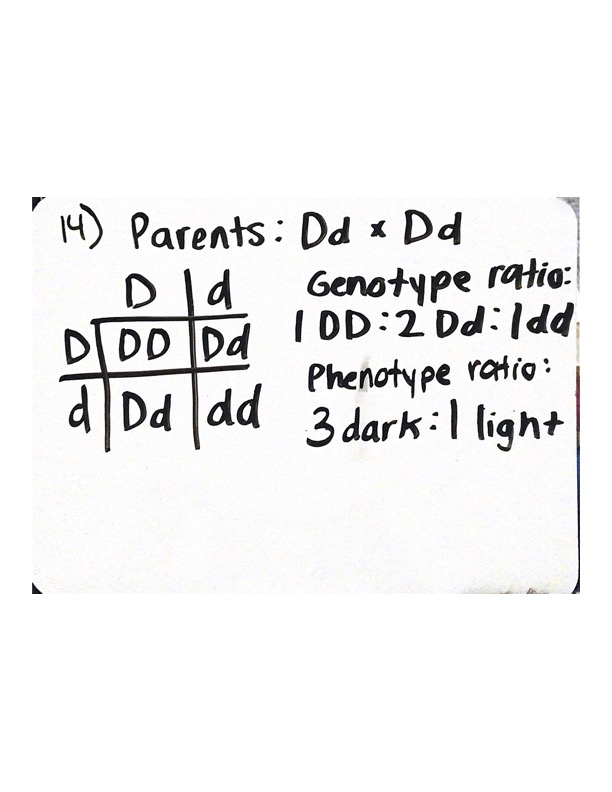
15
New cards
*Make a Punnett Square and list the genotype and phenotype ratios*
\
**B. In pea plants, round seeds (R) are dominant to wrinkled seeds (r), and tallness (T) is dominant to** \n **shortness (t). A tall plant with wrinkled seeds (rrTt) is crossed with a tall plant with round seeds (RrTT).** \n **Complete a dihybrid Punnett, then list the phenotype ratio.**
\
**B. In pea plants, round seeds (R) are dominant to wrinkled seeds (r), and tallness (T) is dominant to** \n **shortness (t). A tall plant with wrinkled seeds (rrTt) is crossed with a tall plant with round seeds (RrTT).** \n **Complete a dihybrid Punnett, then list the phenotype ratio.**
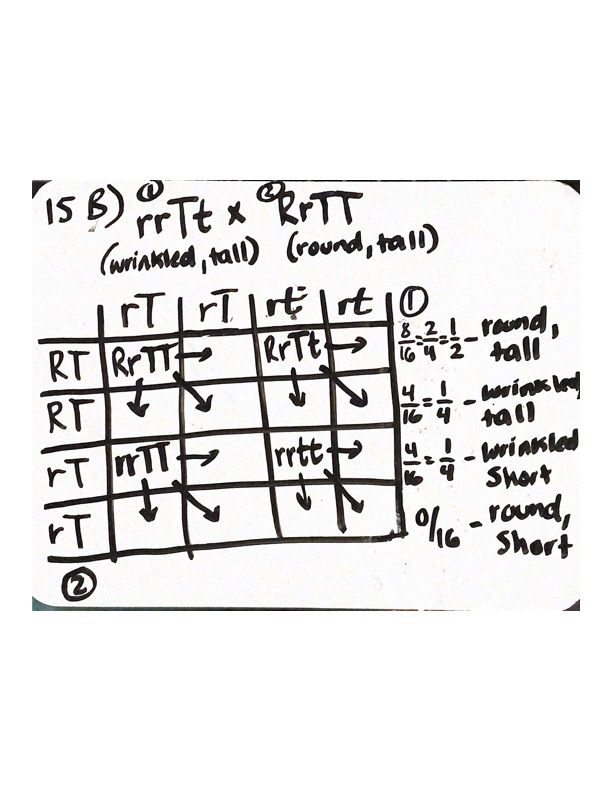
16
New cards
*Make a Punnett Square and list the genotype and phenotype ratios*
\
**C.** **The gene for fur color in cats is controlled by incomplete dominance. Brown cats (B) are dominant, and white cats (b) are recessive. Orange-cats are heterozygous. An orange cat mates with an orange cat.**
\
**C.** **The gene for fur color in cats is controlled by incomplete dominance. Brown cats (B) are dominant, and white cats (b) are recessive. Orange-cats are heterozygous. An orange cat mates with an orange cat.**

17
New cards
*Make a Punnett Square and list the genotype and phenotype ratios*
\
**D. The gene for coat color in cows is controlled by codominance. Red cows (R) are dominant, and white cows (W) are also dominant. Cows who are heterozygous have red spots and white spots and are called “roan.” A roan cow mates with a white cow**
\
**D. The gene for coat color in cows is controlled by codominance. Red cows (R) are dominant, and white cows (W) are also dominant. Cows who are heterozygous have red spots and white spots and are called “roan.” A roan cow mates with a white cow**
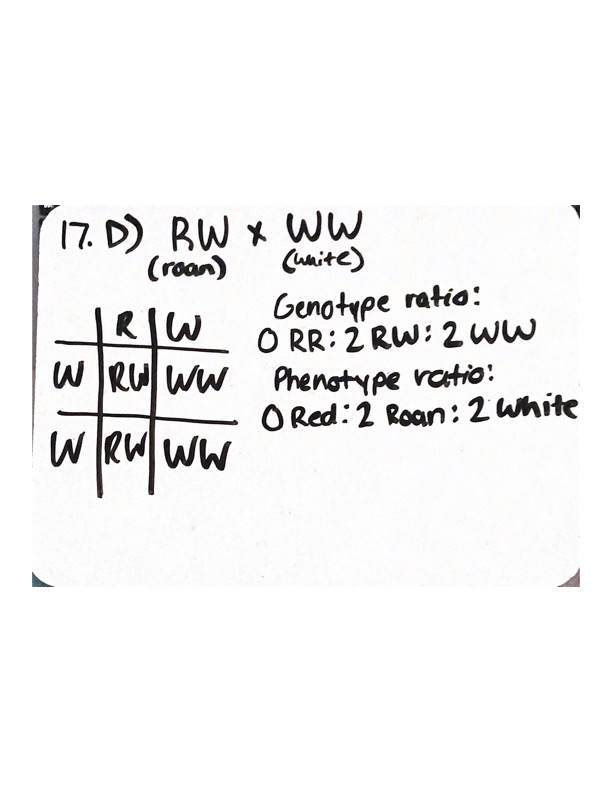
18
New cards
*Make a Punnett Square and list the genotype and phenotype ratios*
\
**E. Human blood types are controlled by multiple alleles. There are 3 alleles - A, B, and O - for one gene. Combinations of these 3 alleles determine a person’s blood type as Type A, Type B, Type AB, or Type O. A person with Type A blood (AO) has children with a person with Type B blood (BO).**
\
**E. Human blood types are controlled by multiple alleles. There are 3 alleles - A, B, and O - for one gene. Combinations of these 3 alleles determine a person’s blood type as Type A, Type B, Type AB, or Type O. A person with Type A blood (AO) has children with a person with Type B blood (BO).**
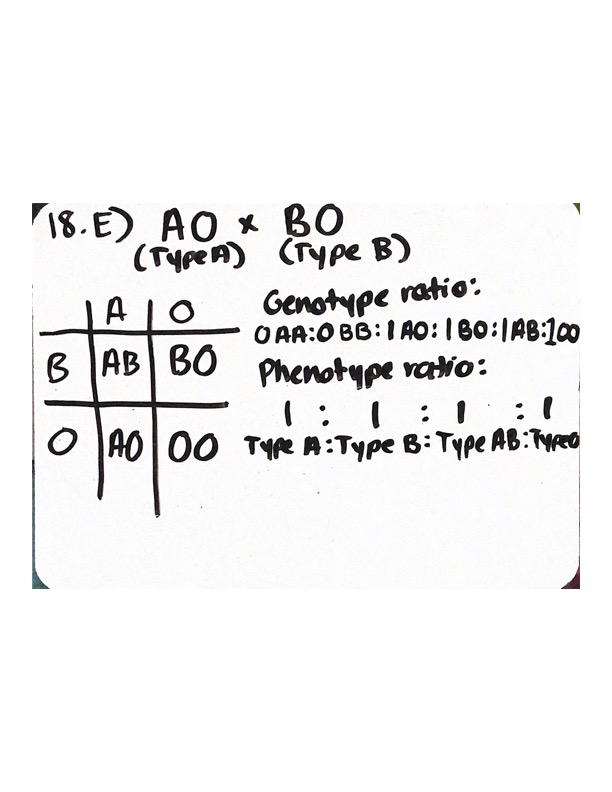
19
New cards
*Make a Punnett Square and list the genotype and phenotype ratios*
\
**F. Male pattern baldness is a human trait controlled by a gene that is inherited on the X chromosome. A dominant allele gives a person no baldness (B), and a recessive allele gives a person male pattern baldness (b). Despite being called “male” pattern baldness, females can also have this trait. A heterozygous female has children with a man with baldness.**
\
**F. Male pattern baldness is a human trait controlled by a gene that is inherited on the X chromosome. A dominant allele gives a person no baldness (B), and a recessive allele gives a person male pattern baldness (b). Despite being called “male” pattern baldness, females can also have this trait. A heterozygous female has children with a man with baldness.**

20
New cards
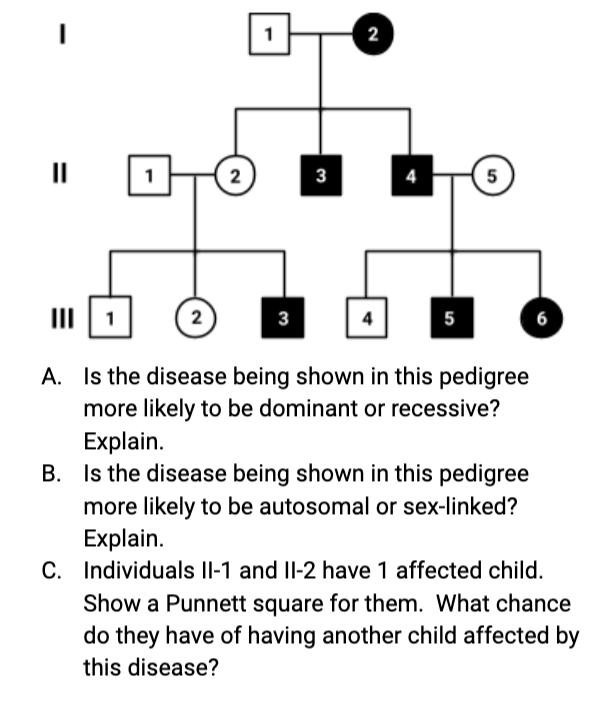
*(+) Referring to Q. 5 in the study guide (photo uploaded here)*
A. __Most likely Recessive,__ II-1 and II-2 appear as unaffected but produce an affected offspring which is a characteristic of a recessive pedigree which makes sense since II-2 had an affected parent and is therefore a carrier
\
B. __Most likely Sex-linked,__ The affected mother in Gen I lead to 2 affected sons in Gen II which is a characteristic of Sex-linked recessive. Also a majority of males are affected in this pedigree which is also a characteristic of sex-linked recessive
\
C. (Image attached)
* *If the pedigree is most likely Sex-linked Recessive, we know that II-2 has a genotype of X^BX^b (their affected mother from Gen I made her a carrier of the recessive allele, and to have an affected son but be unaffected herself she must be heterozygous)*
* *The father is also unaffected and can only carry 1 X allele which must be X^B to be unaffected*
* Even though they already have an affected son, the odds of having another affected child remains the same
\
B. __Most likely Sex-linked,__ The affected mother in Gen I lead to 2 affected sons in Gen II which is a characteristic of Sex-linked recessive. Also a majority of males are affected in this pedigree which is also a characteristic of sex-linked recessive
\
C. (Image attached)
* *If the pedigree is most likely Sex-linked Recessive, we know that II-2 has a genotype of X^BX^b (their affected mother from Gen I made her a carrier of the recessive allele, and to have an affected son but be unaffected herself she must be heterozygous)*
* *The father is also unaffected and can only carry 1 X allele which must be X^B to be unaffected*
* Even though they already have an affected son, the odds of having another affected child remains the same
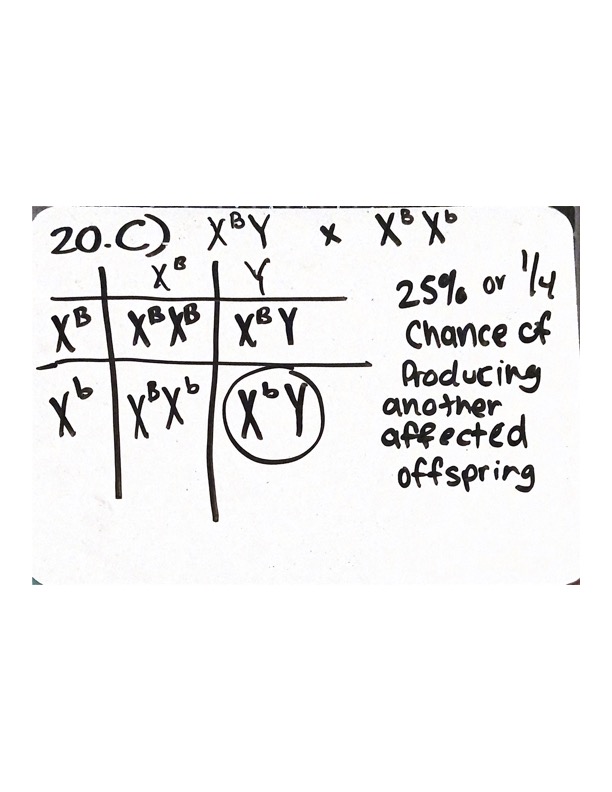
21
New cards

*(+) Referring to Q. 5 in the study guide (photo uploaded here)*
D. __Most likely recessive,__ the disease appears to skip a generation in Gen I, and also there are unaffected parents that have affected offspring (Gen I with II-2; Unaffected II-4 & II-5 producing affected III-5 & III-6
\
E. __Most likely autosomal,__ there isn’t a pattern of affect mothers leading to affected sons (sex-linked recessive) or affected fathers leading to affected daughters (sex-linked dominant). There doesn’t appear to be a majority of affected males (a characteristic of sex-linked recessive)
\
F. (Image attached)
* *If this is most likely an Autosomal recessive pedigree, and the offsprings in Gen III are affected, the both parents must be carriers of the recessive allele if they are unaffected (aka heterozygous)*
* And the odds of producing another affected offspring (aa) remains the same despite already having affected offspring
\
E. __Most likely autosomal,__ there isn’t a pattern of affect mothers leading to affected sons (sex-linked recessive) or affected fathers leading to affected daughters (sex-linked dominant). There doesn’t appear to be a majority of affected males (a characteristic of sex-linked recessive)
\
F. (Image attached)
* *If this is most likely an Autosomal recessive pedigree, and the offsprings in Gen III are affected, the both parents must be carriers of the recessive allele if they are unaffected (aka heterozygous)*
* And the odds of producing another affected offspring (aa) remains the same despite already having affected offspring
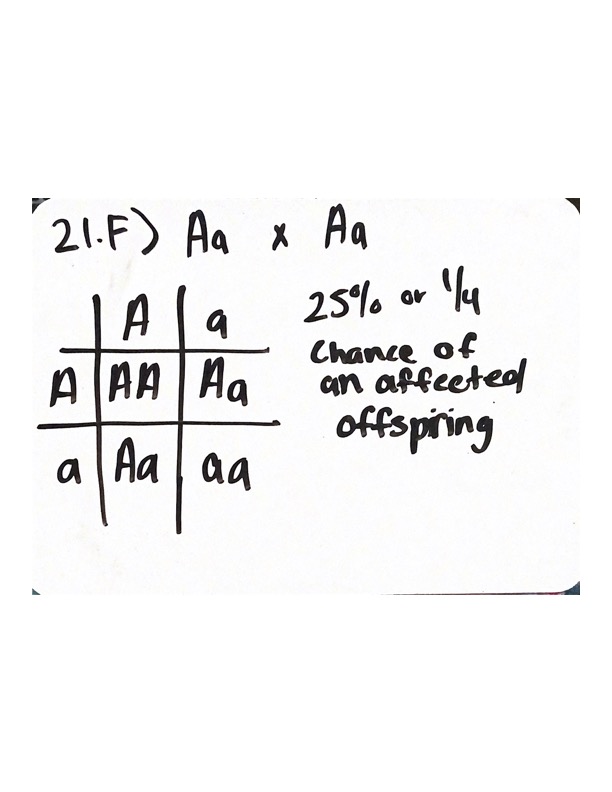
22
New cards

(image attached)
* Gen I, The affected mother → all her offspring are affected (male and female)
* The Gen II-affected daughter of Gen I produced all affected offspring, but the Gen II-affected son did not produce any affected offspring
* This makes sense since an affected mother leads to all affected offspring
* An affected father does not pass on mitochondrial mutations to his offspring since mitochondrial DNA is only inherited from the mother
* The Gen II-affected daughter of Gen I produced all affected offspring, but the Gen II-affected son did not produce any affected offspring
* This makes sense since an affected mother leads to all affected offspring
* An affected father does not pass on mitochondrial mutations to his offspring since mitochondrial DNA is only inherited from the mother
23
New cards
Chi-Square test Practice Problems are on the study guide sheet (flip for general formula)
The sum of ((O-E)^2)/E for each phenotype = Chi-squared
* If Chi-square is less than the critical value (found using the table) then fail to reject the null hypothesis *→ follows Mendelian Inheritance/fits predicted phenotype ratio*
* If Chi-square is greater than the critical value, then reject the null hypothesis → *does* __***NOT***__ *follow Mendelian Inheritance/doesn’t fit the predicted phenotype ratio*
* If Chi-square is less than the critical value (found using the table) then fail to reject the null hypothesis *→ follows Mendelian Inheritance/fits predicted phenotype ratio*
* If Chi-square is greater than the critical value, then reject the null hypothesis → *does* __***NOT***__ *follow Mendelian Inheritance/doesn’t fit the predicted phenotype ratio*
24
New cards
Difference between Linked and Unlinked genes
**Linked Genes**
* Do __***NOT***__ assort independently
* Are on the SAME chromosome, close together
* Tend to be inherited together
* Lower chance of producing recombinant gametes
* gametes that are a combination of both parent’s alleles
**Unlinked Genes**
* Do assort independently
* Location
* Genes that are on SEPARATE chromosomes
* Genes that are on the SAME chromosome, but VERY FAR apart
* Do __***NOT***__ assort independently
* Are on the SAME chromosome, close together
* Tend to be inherited together
* Lower chance of producing recombinant gametes
* gametes that are a combination of both parent’s alleles
**Unlinked Genes**
* Do assort independently
* Location
* Genes that are on SEPARATE chromosomes
* Genes that are on the SAME chromosome, but VERY FAR apart
25
New cards
Recombination Frequency (Practice on the study guide, flip for general equation)
RF = \[(The number of recombinant offspring) / (Total offspring) \]x 100
26
New cards
Gene Mapping Tips
* 1 % recombinant frequency = 1 map unit/centimorgan
* Large RF = further apart = more likely to cross over
* Smaller RF = close together = less likely to cross over
* RF “maxes out” at 50%
\
*personal tip: If asked to draw the map:*
* __*to figure out which genes are on the ends of a chromosome,*__ *find the genes with the largest RF and map them on opposite ends of the drawing*
* *Using the smallest RF, t*__*ells you which of the ends 1 of the genes is*__ *(*==***ex. with the study guide problem***== *W + Z are the smallest RF, therefore W is closest to the Z end of the chromosome)*
* *Then check to make sure that the locations you’ve mapped match up with what the RF’s tell you*
* ==From the study guide==
* EX. If X + Y is 21% and X + Z is 33%, Y should be closer to X than Z is
* EX. If W + Y is 13 % and W + X is 28%, Y should be closer to W than X is
\
* Large RF = further apart = more likely to cross over
* Smaller RF = close together = less likely to cross over
* RF “maxes out” at 50%
\
*personal tip: If asked to draw the map:*
* __*to figure out which genes are on the ends of a chromosome,*__ *find the genes with the largest RF and map them on opposite ends of the drawing*
* *Using the smallest RF, t*__*ells you which of the ends 1 of the genes is*__ *(*==***ex. with the study guide problem***== *W + Z are the smallest RF, therefore W is closest to the Z end of the chromosome)*
* *Then check to make sure that the locations you’ve mapped match up with what the RF’s tell you*
* ==From the study guide==
* EX. If X + Y is 21% and X + Z is 33%, Y should be closer to X than Z is
* EX. If W + Y is 13 % and W + X is 28%, Y should be closer to W than X is
\